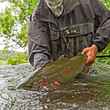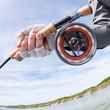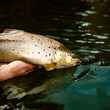Chances are, watching guide Santos Madero work a streamer is like nothing you've seen before. Instead of the long casts, big mends and extended swings or retrieves most anglers associate with streamer fishing, Madero works short. Really short; with stout, heavy flies intended to get to the bottom fast and move water. Casts are typically quartered upstream into fast water seams, tight to the trees or banks or other cover and are followed by brief swings—sometimes as little as a second or two—which are punctuated by short, relatively sharp jerks on the line or where the fly is drawn broadside through the target water. And then the whole thing is set in motion again and again, as Madero moves quickly through a run.
Seeing it for the first time, you might be prone, like me, to give a bit of a chuckle. Or glance at your buddy beside you with a bewildered look, wondering who could possibly expect such a fevered, almost violent style of fishing to yield any results. Only then the hookups start coming. And coming. Flies that are smacked onto the surface and seem like they've barely been in the water for even a second are snatched away by hungry, waiting trout.
Fish with Madero regularly, and you'll get used to seeing him pull trophy fish from the most unlikely of places using this tactic—places where it's doubtful you'd be able to present a fly using any other method.
What you're watching isn't some form of streamer wizardry, it's Madero fishing a sculpin pattern properly.
Streamers, as most anglers know, are intended to imitate a wide variety of larger, swimming prey—leeches, crayfish, hellgrammites and, perhaps most commonly, baitfish. It's to that latter group of swimming prey that sculpins belong. Sculpins, which are found virtually everywhere that trout swim and typically in large numbers, are small baitfish that are an important food source for trout. And while sculpins are typically smaller, they can be as large as 6 or 7 inches long, making them an especially important food source for large trout. It's for this reason that so many popular streamer patterns are intended to imitate or work well as imitations of sculpins—think Sculpzilla, Sex Dungeon, Drunk and Disorderly, the vast majority of bulky, modern articulated flies and, of course, the classic Muddler Minnow.
Two important differences between sculpins and other other swimming baitfish—minnows, small trout, alewives, trout-perch and so on—is that sculpins lack an air bladder (which provides fish buoyancy) and are considered relatively poor swimmers. What sculpins do have, however is large, fanlike pectoral fins and a tapered, flattened body shape which allow them to hug the bottom and stay put, even in most rivers' fastest water. Sculpins are ambush predators that don't move much (most sculpin's entire range is less than 150 feet), but when they do, it is most commonly by dislodging themselves from the bottom and drifting briefly before navigating in short, sharp bursts.
It is these swimming patterns and behaviors of sculpins that make traditional streamer tactics which feature long and consistent retrieves, extended swings and which cover large distances less productive when fishing sculpin patterns. And, it's what makes Madero's method—and others that use short, quartering upstream casts followed by broadside swings or sharp, swift strips—so much more effective.
That's not to say that you can't fish a sculpin pattern using more traditional streamer methods. You can, if for no other reason than most sculpin patterns also serve as good imitations of many other baitfish. But fishing sculpin patterns in a way that imitates sculpin behavior is not only a productive method, but one that often opens up new water for many anglers. It's also a hell of a lot of fun and for that reason alone should be added to your arsenal of streamer tactics.
































Comments
Jay replied on Permalink
Do you have any video or links to a video of him executing this technique?
Eli replied on Permalink
Video would be very helpful here!
Yohji ono replied on Permalink
I can’t wait to try this out. Honest question here — For such a short cast, aside from finesse and feel, could a 11 foot spinning rod with same sculpin pattern also be used almost as effectively? Really just curious, so purists please be kind thanks!
Pages